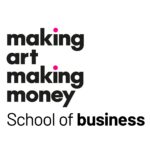What Won't You Learn in Art School?
What Won’t You Learn In Art School?
(Transcription)
Artist, Debbie Baxter
Cambridge, England
QUESTION: What did you find in art school?
Debbie Baxter: When I went to look at the art schools, which filled me with dread.
Ann Rea: What filled you with dread? When you looked at the art schools, like, give me one specific example.
Debbie Baxter: So, if you go to St. Martins on the Fields, which is one of the biggest art schools in London, it’s a bit like a warehouse. You walk in, and it’s a labyrinth of rooms, chambers, corridors, all whitewashed. Big windows, big, sort of areas dedicated to each student. So, basically, they’d have a big wall space, a corner of a room, and all their equipment, and they’d be there for three years.
Ann Rea: Wait, it reminds me of my school, which was, part of my school, was a renovated Model T car factory, and we had that same sort of set up. Whitewashed partitions and our own little space to create–
Debbie Baxter: Yeah, yeah, yeah. And the feeling of dread, I remember it, because I happened to walk past a tutor working with a student and the whole atmosphere felt depressed. I felt depressed the moment I walked in, and I overheard him say the words, “So, tell me about your feeling, tell me about the thing, express your feeling, You know, talk to me about how did you feel when you made this?” You know, and immediately, it’s like my bullshit radar picked up and went, “This does not feel good.” You know, I don’t know what it is, but I don’t want to spend three years of my life hidden in this dusty corner trying to explain to a complete stranger the reason why I made a mark. It felt empty. It felt like it was just playing, you know. It was a joke for an education. I wanted something more disciplined.
QUESTION: What did they tell you about making a living?
Debbie Baxter: At the end of the interview, I asked her, “So what do you do in terms of business? Do you do any training in terms of business? Like after my degree, what do you offer as a next step?” And she just flat-lined. She couldn’t, there was nothing in her cache that could give me any inform, well, she went, “Uh, uh, um, well, we don’t.”
Ann Re: They don’t. Exactly. They don’t. They don’t, and you know, to be fair, they just don’t know how.
Debbie Baxter: If they knew how–
Ann Rea: They don’t know how. By and large, By and large, they wouldn’t be teaching in an art school.
Debbie Baxter: Yeah.
Ann Rea: Because they would be making their art and selling their art. There are some exceptions. I had a mentor who was a very famous, he was a really Renaissance man. He was a very famous industrial designer, painter and ceramicist. But he was a complete entrepreneur. So he was a ceramicist, but he owned a ceramic factory.
Debbie Baxter: Wow. Wow.
Ann Rea: He was an industrial designer, but he owned the patents and he resold them at a profit.
Debbie Baxter: Wow. So, smart guy.
Ann Rea: So, very different mindset. I regret, His name was Viktor Schreckengost. I regret that he never formulated a curriculum around his mindset and how he went about making money, because he made a lot of money, but I can tell you that I was definitely influenced by him, just by watching him. Although he didn’t teach me anything about the mechanics of how to build a business, I could see that he was. And he was different from all of the other art professors, and he was the most favored, most celebrated professor in the entire school. So isn’t that interesting?
Debbie Baxter: Yeah.
Ann Rea: So I would say, I would like to acknowledge and credit his influence for what I’m doing right now. Because I found it completely frustrating, soul-sucking, daunting to not receive instruction, and to get messages from professors that were so disempowering.
QUESTION: What was the underlying message?
Debbie Baxter: You have to be found. That’s the main content of the teaching at the beginning, is that you just keep painting and painting and painting, until you’re found, and–
Ann Rea: What a passive, What a passive way to go about life. Someone find me while I’m hiding in my studio.
Debbie Baxter: Yeah, the more I think about it, there was this passive underlying message. And that is, you’ll never be good enough until you can prove it to the whole wide world that you are.
Ann Rea: And you don’t need to prove it to the whole wide world. You really just only need to prove it to a certain number of very select collectors.
Debbie Baxter: Well, he read the message. He conveyed the message so well, that I walked away. I actually stopped painting. I just thought, “Well, okay, then I’m defeated.” I couldn’t find it in myself to put myself through it. I couldn’t find the way that meant what I needed it to mean, because I felt lost.
QUESTION: What was the underlying message?
Ann Rea: You have to go find your, you have to go find your target market. They’re not coming to find you. They have other things to do. So, if that–
Debbie Baxter: See, that never, I never knew that. I never knew that, I suppose in a way, I was, you always have your head pointed towards the outside world. You don’t have your head pointed towards who you are. And I don’t believe, and I still get this from people who’ve done a fine art degree, is that they come out more lost with themselves–
Ann Rea: Yes.
Debbie Baxter: So they wouldn’t really know where to go, what to do. They don’t have the skill base, so that, some of them, I’ve actually been on courses with, where they’ve said to the tutor, “Do you know, they never taught me this, that art degree course.” You know, “They never taught me how to mix color, they never taught me how to do composition. I never really knew the importance of this, that, or the other.” Which is just basic, you know, training. So that was never put across, and plus the fact they didn’t know what to do. You know, they come and do a course, and they don’t know what to paint, because they’re so far removed from themselves, they don’t know what to connect to to start the process.
Ann Rea: Unfortunately, I hear this a lot, that people spend enormous amounts of money and time in investing in a fine art degree, whether it’s a Bachelors of Fine Art, or a Masters of Fine Art, at least here in the United States, and they come out not knowing really basic, basic, basic stuff. If you went to, if you went to any other school to acquire any other degree, that would be completely unacceptable. I mean, they would be simply shot down.
QUESTION: How is this program different?
Ann Rea: You know, I love watching my students take their power back. It’s fun. It’s really fun from the other side. I get to see them, you know, cheering each, you guys cheer each other on.
Debbie Baxter: Yeah, I’ve got some really fantastic study partners, but, you know, I look forward every time we book, and we do it every week, I look forward to knowing that I’ve, someone’s got my back. Someone’s gonna support me emotionally through all of the steps that we’re going through, and once you get to know them and you know how they work and you know their art, you feel like you can support each other in a way, I’ve never ever had that before. You know, to this degree. And someone you really like talking to and hanging out with and sharing and moving through it’s fantastic. This is, for me, the beauty about the course, is that when I say it’s the gift that keeps on giving, it’s that I never expected there to be so much depth to it, or so much content that would keep me moving in the right direction. I mean, sometimes your paying for a course and you’ll get, you know, you’ll get it shown to you and you think, okay, there’s maybe three chapters’ worth of work, but it’s quite shallow.
Ann Rea: Right.
Debbie Baxter: And in this course, what blows me away, is the level it keeps going through in order to get where you need to get to to get what you want. That blows me away. I never expected, and I have to say it’s very good value for money, when I think about the content, if I’m still only halfway through.
QUESTION: Have a hard time calling yourself an artist?
Ann Rea: You know, I want to encourage artists, if you’ve quit making art, and you have a hard time calling yourself an artist, it’s okay. I mean, so many artists, for various reasons, had to quit. They had to put it on pause, and it’s not too late, no matter how old you are, it’s not too late. You can, and even if you haven’t made any art, you can still join this program and you’ll be inspired to make the art, and you’ll sell it. As, you’ll sell your homework. You’ll sell some of it, you might not sell all of it, but that’s, you don’t need a body of work to start this. What you need is the right mindset. What you need is a support system, and you need a proven road map that actually has been proven, time and time and time again.
QUESTION: Should other artists apply to enroll?
Debbie Baxter: The first question I would ask them is, “What do you want? As an artist, what do you really want?” And I can, you know, be absolutely certain that whatever they want is there for them in this course. And I think that would be the most simple way of doing it. It is, you know, what do most artists want? They want recognition. What does that mean? Does it mean to sell more paintings, or does it mean to be known in their environment? So, it’s actually, it’s not the painting that they want, it’s something within themselves that they want to express, and that’s what all artists are doing. They’re trying to find something inside of themselves that has meaning for them. And that’s why they’re calling for recognition. It’s not almost as if, they don’t need the outside world to give them the recognition, they need to find their own recognition in order to get their, to satisfy that part that they’re looking for.
Ann Rea: Yeah–
Debbie Baxter: That’s what I feel.
Ann REa: I always say, it’s not about you. It’s not about you, it’s about your target market. If you make it about them, then it will be all about you. But you have to make it about them. You have to give them value. And by the way, it’s not just for painters. We have, I mean, I’m sure I have artists who come from more than this number, but I’ve counted 17 different types of creative discipline. So I’m a painter–
Debbie Baxter: On the course?
Ann Rea: Yeah.
Debbie Baxter: Oh wow. Wow!
Ann Rea: 17 different types of creative, you know, jewelry design, we’ve got jewelry designers, we’ve got glass blowers, we have sculptors, and now we’re up to 19 different countries. So I’m, you know, I’m American–
Debbie Baxter: Cool.
Ann Rea: You’re British. We’ve got, there are 19 different countries now!
Debbie Baxter: I teach, and I understand the value of education. And the value of education, when it’s done properly, is like a gift from heaven, really.

About Ann Rea
Ann Rea is a San Francisco-based artist and the creator of The Making Art Making Money program. Her art and business savvy have been featured on ABC, HGTV, Creative Live, The Good Life Project, in the book Career Renegade by Jonathan Fields, by the San Francisco Chronicle, Art Business News, Fortune, and Inc. Magazines. Rea’s artistic talent is commended by her mentor, art icon, Wayne Thiebaud.

